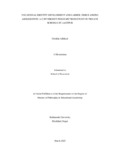
Please use this identifier to cite or link to this item:
https://hdl.handle.net/20.500.14301/479| Title: | Vocational Identity Development and Career Choice among Adolescents: A Convergent Mixed Methods Study in Private Schools of Lalitpur |
| Authors: | Adhikari, Uttsikha |
| Citation: | Adhikari,U.(2025).Vocational identity development and career Choice among adolescents: A convergent mixed methods study in private schools of alitpur. |
| Issue Date: | Mar-2025 |
| Publisher: | Kathmandu University School of Education |
| School: | SOED |
| Department: | DOEL |
| Level: | M.Phil. |
| Program: | MPhil in Educational Leadership |
| Abstract: | Vocational Identity Development (VID) is the development of clarity about an individual's self, including personality, abilities and intelligence, values, and interests and aspirations. Without VID, adolescent students get confused about their higher academic endeavors and join higher studies that do not match their ideal job. This causes distortion among adolescents about their interests and passions, leading to random and incompatible career choices. Since adolescents learn and explore the most at school, the VID of adolescents is highly dependent on school practices. This research aimed to examine the impact of VID practice on career choice among adolescents and explore their experiences of VID for class teachers and students. Concurrent triangulation mixed methods research was employed to handle the twofold facets of the problem: the existence of relative objectivity and multiple reality, the need to find out both subjective and objective opinions, and the interplay in the value as a researcher. A multi-paradigmatic approach utilizing both post positivist and interpretive ways was used in this research where 215 class teachers of either Grade 9 or 10 from private schools of Lalitpur district participated in the survey, and one class teacher of Grade 9 and one student of Grade 10 each from three different schools participated in the qualitative semi-structured interviews. The quantitative research findings suggested that the activities conducted in schools for adolescents support VID and that VID positively impact adolescents' career choices. Qualitative findings also highlight the key practices that class teachers and students believe support VID. The qualitative findings from the experiences of class teachers suggest that various programs and activities conducted in school, constant encouragement to students, and involvement of parents are the major practices that support the VID of adolescents at school. Similarly, the qualitative findings from the students’ perception found various school programs and activities, teachers’ efficiency, and disciplinary measures to be the major school practices that impact their VID. From the qualitative and quantitative findings, it is evident that VID and clarity in career choice among adolescents can be developed via various practices at school. School practice should be cultivated by focusing on the clarity of components of vocational identity. In conclusion, the study highlights the necessity of educators being aware of the impact of their practices on students' VID. It also encourages the school leaders to design school and classroom practices for adolescents to explore their vocational identity in school settings. It further suggests certain interventions like increasing the efficiency of class teachers to keep the students engaged, motivated, and eager to learn, and increasing parental involvement in school settings to make them aware of the importance of exploration of VID and jointly working for the VID of adolescent students. |
| URI: | https://hdl.handle.net/20.500.14301/479 |
| Appears in Collections: | Dissertation |
Files in This Item:
| File | Description | Size | Format | |
|---|---|---|---|---|
| Uttsikha Adhikari Final Dissertation after Viva (1).pdf | 3.64 MB | Adobe PDF |  View/Open |
Items in DSpace are protected by copyright, with all rights reserved, unless otherwise indicated.